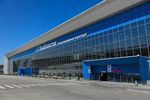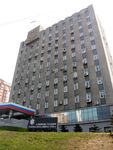Short Description of the Russian Far East and Vladivostok city - DITP
←
→
Page content transcription
If your browser does not render page correctly, please read the page content below
Short Description of the Russian Far East and Vladivostok city The Russian Far East (Dal’niy Vostok Rossii) is the Russian part of the Far East, the extreme east parts of Russia, between Lake Baikal in Eastern Siberia and the Pacific Ocean. The Far Eastern Federal District, which covers this area, borders with the Siberian Federal District to the west. The Far Eastern Federal District has land borders with the People's Republic of China and North Korea to the south west and maritime borders In Russia, the region is usually referred to as just "Far East". What is known in English as the Far East is usually referred to as "the Asia-Pacific Region”, abbreviated to АТР. In 2010 Census, Far Eastern Federal District had a population of 6,3 million people. Most of it is concentrated in the southern parts. Given the vast territory of the Russian Far East, 6.3 million people translates to slightly less than one person per square kilometer, making the Russian Far East one of the most sparsely populated areas in the world. The largest cities are: Vladivostok, Khabarovsk, Komsomolsk-on-Amur, Blagoveshchensk, Yakutsk, Petropavlovsk-Kamchatsky, Yuzhno-Sakhalinsk, Nakhodka, Ussuriysk. The region is connected with the rest of Russia via Trans-Siberian Railway and Baikal–Amur Mainline (since 1984) provide connection with Siberia. For many remote localities aviation is the main mode of transportation to/from the civilization. Maritime transport is also important for delivering supplies to localities at (or near) Pacific and Arctic coasts. Vladivostok is a city and the administrative center of Primorsky Krai located at the head of the Golden Horn Bay, not far from Russia's borders with China and North Korea. The population of
the city as of 2016 is 606,653 recorded in the 2010 Russian census. The city is the home port of the Russian Pacific Fleet and the largest Russian port on the Pacific Ocean. Vladivostok's yearly mean of temperature is around 5 °C (41 °F) is some ten degrees lower than in cities on the French Riviera on a similar coastal latitude in Europe on the other extreme. In winter, temperatures can drop below −20 °C (−4 °F) while mild spells of weather can raise daytime temperatures above freezing. The average precipitation, mainly in the form of snow, is around 18.5 millimeters (0.73 in) from December to March. Snow is common during winter, but individual snowfalls are light, with a maximum snow depth of only 5 centimeters (2.0 in) in January. During winter, clear sunny days are common. Summers are warm, humid and rainy, due to the East Asian monsoon. The warmest month is August, with an average temperature of +19.8 °C (67.6 °F). Vladivostok receives most of its precipitation during the summer months, and most summer days see some rainfall. Cloudy days are fairly common and because of the frequent rainfall, humidity is high, on average about 90% from June to August. The city's main industries are shipping, commercial fishing, and the naval base. Fishing accounts for almost four-fifths of Vladivostok's commercial production. Other food production totals 11%. A very important employer and a major source of revenue for the city's inhabitants is the import of Japanese cars. Besides salesmen, the industry employs repairmen, fitters, import clerks as well as shipping and railway companies. The Vladivostok dealers sell 250,000 cars a
year, with 200,000 going to other parts of Russia. Every third worker in the Primorsky Krai has some relation to the automobile import business. In recent years, the Russian government has made attempts to improve the country's own car industry. This has included raising tariffs for imported cars, which has put the car import business in Vladivostok in difficulties. To compensate, Prime Minister Vladimir Putin ordered the car manufacturing company Sollers to move one of its factories from Moscow to Vladivostok. The move was completed in 2009, and the factory now employs about 700 locals. It produced 31,800 cars in Vladivostok in 2015. In 2015, a special economic zone has been settled with the free port of Vladivostok. The 'Free port of Vladivostok is a free port, which means a port zone under a special custom and taxation system, with a particular jurisdiction regarding investments. The project was intended to improve the cross-border commerce, to develop the transport infrastructures and to integrate the Primorsky Krai in the world transportation routes. Its purpose is also to attract investors, to create a network of logistic centers for transportation, storage and partial transformation of the goods, in order to foster the organisation of local industries working on the exportation of manufactured goods to create added value. The federal law N212-FZ «of Vladivostok free port» has been signed by the President of the Russian Federation on July 13 of 2015; the law is effective from October 12 of 2015. The law specifies that the free port regime in Vladivostok will last for 70 years, and that the period could be renewed by an additional law. Residents of the free port are granted some privileges: light taxation, simplified customs and visa procedures, facilitated administration procedures.
In the free port zone, the following rules are settled:
- Facilitated visa regime (possibility to get a 8-days visa at the border);
- Modern and fast system of border crossing for international business;
- State support to entrepreneurs in order to attract investments for the development of
transport infrastructures, the creation and development of an industry oriented
towards export on the Asia-Pacific market;
- Significant reduction of the tax inspection delays;
- Lowered taxes on income for investors (instead of the usual 20%, 5% during the first 5
years, then 12% during the following 5 years);
- No tax on property or buildings during the first 5 years;
- Especially lowered social welfare contributions on investment projects during the first
10 years (7.6% instead of the usual 30%), decreased tax on mine resources extraction,
and accelerated procedure for getting VAT back;
Benefiting the creation of the free port, a zone dedicated to casinos has been opened, with the
ambition to make of Vladivostok a gambling place, as a rival of Macau and Busan. In total, 16
hotels and casinos, with side leisure infrastructures (nautical base, ski tracks, etc.) should be
built till 2022; part of them should be completed in 2016. The total invested amount represents
more than 1.5 billion euros.
According to the economical growth assessment made by the experts, the creation of the free
port of Vladivostok should lead to an increase of the GRDP of the Primorsky Krai, reaching 2.2
times its initial rate in 2025 (up to 1 400 billion rubles) and 3.4 times in 2034 (up to 2 100 billion
rubles). Newly created jobs are also forecasted, up to 84 000 in 2021, 108 000 in 2025, and 468
000 in 2034.
Vladivostok (space view)Vladivostok Sea Port Ty Far Eastern State University Source: Marketing Representative under supervision of Thai Trade Center-Moscow, 21 October 2016
You can also read



























































